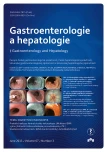Nitrergic innervation of small intestine in rats after ischemic-reperfusion injury
Authors:
A. Boleková 1; T. Špakovská 1; D. Kluchová 1; Š. Tóth 2; J. Veselá 2
Authors‘ workplace:
Ústav anatómie LF UPJŠ v Košiciach
1; Ústav histológie a embryológie LF UPJŠ v Košiciach
2
Published in:
Gastroent Hepatol 2013; 67(3): 202-206
Category:
Clinical and Experimental Gastroenterology: Original Article
Overview
Even nowadays, multiple organ failure syndrome still causes high mortality, therefore it needs special attention. Endothel of the small intestine causes bacterial translocation as well as local and systemic inflammation, the main pathophysiological changes that lead to the development of the syndrome. Nitric oxide is a nonadrenergic and noncholinergic neurotransmitter in the intestinal smooth muscle and it plays an important role in the process of ischemic-reperfusion injury.
Methods:
Experimental animals, adult male Wistar rats, were divided into three groups according to the reperfusion period after previous ischemic episode lasting for one hour. The results were compared to a control group without experimental ischemic-reperfusion injury. Samples of the jejunum were histochemically analyzed in order to visualize the nicotinamide adenine dinucleotide phosphate diaphorase, which is a marker of the nitric oxide in the nerve structures.
Results:
The activity of the nitrergic neurons rapidly decreased in the group with one hour reperfusion; consequently, this activity gradually increased in the group with 24 hour reperfusion, and finally in the group with 30 days reperfusion there were no changes in the activity of the nitrergic neurons compared to the control group.
Conclusion:
These results indicated that the jejunal ischemic-reperfusion injury affected the neurons of the enteric nervous system and resulted in early decrease in the activity of the nitric oxide neurotransmitter one hour after the injury. Further gradual increase of its activity 24 hours after ischemic-reperfusion injury could be considered a result of the plasticity process. On day 30 after ischemic-reperfusion injury all the histochemical changes reached control levels. After the compensation mechanisms failure, death occurred within a week after elicited ischemia.
Key words:
ischemic-reperfusion injury – jejunum – innervation
Sources
1. Furness JB. The enteric nervous system. Oxford, UK: Blackwell Publishing 2006.
2. Bone RC, Balk RA, Cerra FB et al. Definitions for sepsis and organ failure and guidelines for the use of innovative therapies in sepsis. The ACCP/SCCM Consensus Conference Committee. American College of Chest Physicians/Society of Critical Care Medicine. Chest 1992; 101(6): 1644–1655.
3. Swank GM, Deitch EA. Role of the gut in multiple organ failure: bacterial translocation and permeability changes. World J Surg 1996; 20(4): 411–417.
4. Záhorec R, Veselovský T. Syndróm multiorgánovej dysfunkcie – 1. časť: definícia, patofyziológia a klinické príznaky. Interná Med 2008; 8(10): 529–534.
5. Hope BT, Michael GJ, Knigge KM et al. Neuronal NADPH diaphorase is a nitric oxide synthase. Proc Natl Sci USA 1991; 88(7): 2811–2814.
6. Kimáková T, Krištúfek P, Bernadič M. Problematika voľných radikálov, oxidačného stresu a antioxidantov vo vzťahu k neinfekčným ochoreniam, 1. časť. Monitor medicíny SLS 2011; 3–4 : 13–16.
7. Lovásová K, Miklošová M. The enzymatic activity of NADPH-diaphorase in the sciatic nerve of the healthy rat. Folia Veterinaria 2000; 44(1): 35–38.
8. Qu ZD, Thacker M, Castelucci P et al. Immunohistochemical analysis of neuron types in the mouse small intestine. Cell Tissue Res 2008; 334(2): 147–161.
9. Scherer-Singler U, Vincent SR, Kimura H et al. Demonstration of a unique population of neurons with NADPH-diaphorase histochemistry. J Neurosci Methods 1983; 9(3): 229–234.
10. Rivera LR, Thacker M, Castelucci P et al. The reactions of specific neuron types to intestinal ischemia in the guinea pig enteric nervous system. Acta Neuropathol 2009; 118(2): 261–270.
11. Bódi N, Battonyai I, Talapka P et al. Spatial pattern analysis of nitrergic neurons in the myenteric plexus of the duodenum of different mammalian species. Acta Biol Hung 2009; 60(4): 347–358.
12. Altdorfer K, Fehér E, Fehér J. Distribution and localization of nitric oxide containing neural elements in the digestive tract. Orv Hetil 1996; 137(16): 857–860.
13. Cerqueira NF, Hussni CA, Yoshida WB. Pathophysiology of mesenteric ischemia//reperfusion: a review. Acta Cir Bras 2005; 20(4): 336–343.
14. Radwan K, Bátovský M. Akútna mezenteriálna ischemia. Gastroent Hepatol 2011; 65(1): 9–14.
15. Pontell L, Sharma P, Rivera LR et al. Damaging effects of ischemia/reperfusion on intestinal muscle. Cell Tissue Res 2011; 343(2): 411–419.
16. Osborne DL, Aw TY, Cepinskas G et al. Development of ischemia/reperfusion tolerance in the rat small intestine. J Clin Invest 1994; 94(5): 1910–1918.
17. Vollmar B, Menger MD. Intestinal ischemia/reperfusion: microcirculatory pathology and functional consequences. Langenbecks Arch Surg 2011; 396(1): 13–29.
18. Varga J, Staško P, Tóth Š et al. Morphological and apoptotic changes in the intestinal mucosa and lung parenchyma after ischemic/reperfusion injury of the jejunum. Acta Vet Hung 2010; 58(2): 243–256.
19. Varga J, Tóth Š, Staško P et al. Intestinal ischemia-reperfusion injury – the histopathological status of remote vital organs in acute and subacute phases. Ann Transplant 2012; 17(1): 11–20.
20. Tóth Š, Jonecová Z, Varga J et al. Mesenteric ischemia-reperfusion injury: specific impact on different cell populations within the jejunal wall in rats. Acta Histochem 2012; 114(3): 276–284.
Labels
Paediatric gastroenterology Gastroenterology and hepatology SurgeryArticle was published in
Gastroenterology and Hepatology

2013 Issue 3
Most read in this issue
- Faecal incontinence
- Asacol 800™ mg tablets
- Current position and future trends of therapy in ulcerative colitis
- Health risks of endoscopy for endoscopists in the Czech Republic – a pilot study
